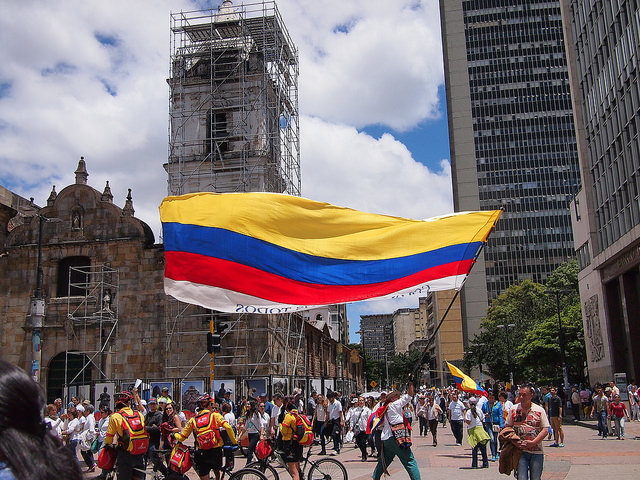Several weeks ago on The Strategist, I discussed why Colombia’s 51-year-old battle against the Revolutionary Armed Forces of Colombia (FARC) may come to an end on 23 March 2016. But as negotiations march towards a peace deal, there are five primary reasons why law enforcement agencies may have to hold off on their celebrations a little longer.
First, the eventual demobilisation of FARC rebels wouldn’t be a fatal setback to Colombia’s illicit narcotics industry. Drug lords have been killed or imprisoned only to be replaced quickly, if not immediately, by their lieutenants. In the early 1990s, the end of the big cartels—Medellin and Cali—gave rise to a new breed of smaller, low profile cartels, including the Norte del Valle cartel.
Second, BACRIM—an acronym from the Spanish Bandas Criminales referring to Colombia’s 17 largest organised crime groups—could become a bigger problem. BACRIM emerged in 2003 when the government struck a peace deal with the United Self-Defense Forces of Colombia (AUC)—Colombia’s right-wing paramilitaries. The emergence of those groups was the unintended consequence of the then promising demobilisation process. They are now Colombia’s number one national security threat.
Third, the National Liberation Army (ELN)—Colombia’s second largest leftist guerrilla group—is still active, so it’s possible that factions of FARC could join ELN’s line-up. But that’s unlikely as a peace accord with FARC would take the ideological struggle from the jungle to the Congress. The government expects FARC becomes a political party once rebels give-in their weapons. And with FARC off the battlefield, a debilitated ELN may have no choice but to move toward a peace process as well.
Fourth, FARCRIM—BACRIM 2.0—could emerge. Those mid-level FARC commanders who are unwilling to embrace a law-abiding life under the peace deal will have sufficient financial incentives to create their own criminal drug running organisations—and stop running drugs for others, including the ruling secretariat negotiators in Havana. And let’s not forget that the revenues that FARC derives from drug trafficking have doubled since 2011.
So bluntly speaking, FARC rebels—particularly those unwilling to disarm—face the trilemma of either joining a BACRIM or the ELN, or forming their own FARCRIM. And with Colombia’s illegal narcotics industry providing fertile ground for continued exploitation, it seems that the FARCRIM scenario is the most rational path to take.
Yet under current negotiations, FARC agreed to help eradicate the illegal drug trade. Over the last 40 years Colombia’s cocaine business has proven to be extremely resilient. Worryingly, UNODC’s 2015 illicit coca cultivation monitoring survey showed Colombia’s cultivation area and production output both increased substantially between 2013 and 2014, growing from 48,000 hectares to 69,000 hectares, and from 290 metric tonnes to 442 metric tonnes respectively.
But even if upon demobilisation FARC rebels didn’t re-engage in the drug trade, a fifth scenario depicts Mexican cartels taking control of Colombia’s narcotics industry. The anti-narcotics directorate of the Colombian Police has warned that such a scenario has been slowly unfolding since 2013. Indeed, it has been reported that some FARC commanders are selling-off some of their drug laboratories and other assets to Mexico’s Sinaloa cartel, as they try to cash-in before a peace treaty is signed.
Colombian law enforcement agencies are well aware that these five scenarios exist, but the prospects that more than one of them will unfold and combine is more than enough to keep authorities awake at night.
Having FARCRIM, Mexican cartels and BACRIM actively operating in Colombia would only confirm law-enforcement agencies have good reasons to be concerned. While a peace deal with FARC is a positive step, we should be realistic about the likelihood that domestic and international, particularly Mexican, players will rush to fill the power vacuum that a neutered FARC will leave.
FARC runs an enticing and lucrative business that isn’t exclusive to narcotics. Indeed, FARC is one of the world’s richest organised crime/terrorist organisations.
While estimates vary, Forbes Magazine reports FARC’s annual turnover to be US$600 million—behind only ISIS and Hamas. However, that’s significantly less than previous estimates from Colombian officials. In 2013, Colombia’s former head of police said that FARC earned as much as US$1 billion. The year before, Former Defense Minister, Juan Carlos Pinzon said that FARC’s net annual revenue should range from US$2.4 billion to US$3.5 billion. However, Pinzon’s estimate only included revenues derived from cocaine production and processing, as well as a ‘tax’ charged on growers and traffickers operating in FARC’s territory.
Illegal mining—particularly gold—is FARC’s second largest revenue source. Yet it’s still unknown how much of the US$4 billion dollar business feeds FARC coffers. Illegal mines are present in over 20% percent of Colombia’s municipalities, affecting over 16,784 hectares of land. Unsurprisingly, in July this year, President Juan Manuel Santos declared war against illegal mining.
FARC has also muscled their way into kidnapping for ransom and extortion. In 2003, the Financial Intelligence Unit (UIAF) revealed that kidnapping represented annual earnings of US$37 million for FARC, while more recent estimates suggest that FARC receives around 10% of the estimated US$1 billion per year earned from extortion in Colombia.
Other criminal activities include a US$5 million cattle rustling business, oil and bank robberies, land appropriation for agricultural exploitation, façade companies, financial investment’s returns and the list continues.
FARC’s estimated fortune accounts for a significant portion of Colombia’s US$14 billion organised crime industry, and also an annual money-laundering operation that is equivalent to over 3% of Colombia’s Gross Domestic Product.
The breadth and depth of the organised crime problem FARC could inherit threatens to spoil the peace-building process in Colombia. So while reaching a peace agreement is a monumental task in and of itself, maintaining that peace will be much harder if an organised crime boom takes place.


